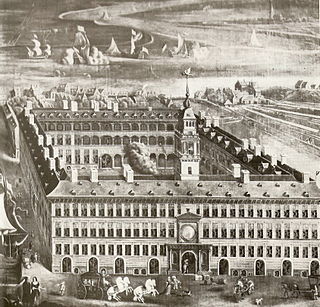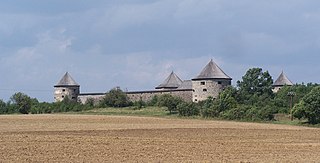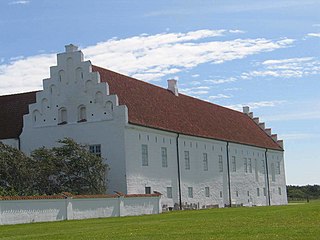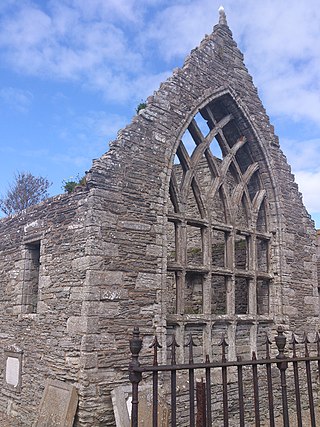Related Research Articles

James Hepburn, 1st Duke of Orkney and 4th Earl of Bothwell, better known simply as Lord Bothwell, was a prominent Scottish nobleman and briefly King consort of Scotland in 1567. He was known for his marriage to Mary, Queen of Scots, as her third and final husband. He was accused of the murder of Mary's second husband, Henry Stuart, Lord Darnley, a charge of which he was acquitted. His marriage to Mary was controversial and divided the country; when he fled the growing rebellion to Norway, he was arrested and lived the rest of his life imprisoned in Denmark.
A vicar is a representative, deputy or substitute; anyone acting "in the person of" or agent for a superior. Linguistically, vicar is cognate with the English prefix "vice", similarly meaning "deputy". The title appears in a number of Christian ecclesiastical contexts, but also as an administrative title, or title modifier, in the Roman Empire. In addition, in the Holy Roman Empire, a local representative of the emperor, such as an archduke, could be styled "vicar".

Hans Hendrik van Paesschen was a Flemish architect, based in Antwerp, who designed high-style classical buildings in many countries of Northern Europe.
Richard Barnes was an Anglican priest who served as a bishop in the Church of England during the reign of Elizabeth I.

Hans Tausen (Tavsen) a.k.a the Danish Luther was the leading Lutheran theologian of the Danish Reformation in Denmark. He served as Bishop of Ribe and published the first translation of the Pentateuch into Danish in 1535.

Christoffer Valkendorff was a Danish-Norwegian statesman and landowner. His early years in the service of Frederick II brought him both to Norway, Ösel and Livland. He later served both as Treasurer and Stadtholder of Copenhagen and finally as Steward of the Realm from 1596 to 1601. He owned Glorup Manor on Funen from 1535 to 1601, whose current main building he constructed, although it has later been adapted in the Neoclassical style. He constructed the old Town Hall in Bergen, and he also constructed Svindinge Church, on Funen, one of the best preserved Renaissance style churches in Denmark. He founded the dormitory Valkendorfs Kollegium in Copenhagen where the street Valkendorfsgade is named after him.

The Church of Our Lady is the cathedral of Copenhagen. It is situated on the Frue Plads public square in central Copenhagen, next to the historic main building of the University of Copenhagen.

Bzovík is a village and municipality in the Krupina District of the Banská Bystrica Region of Slovakia.

James Pilkington (1520–1576), was the first Protestant Bishop of Durham from 1561 until his death in 1576. He founded Rivington Grammar School and was an Elizabethan author and orator.

The Church of the Faroe Islands is one of the smallest state churches in the world. Prior to becoming independent on 29 July 2007, it was a diocese of the Church of Denmark, a Lutheran church. As of 2023, 77.0% of the Faroe Islanders belonged to the state church.

Alsunga is a village in Alsunga Parish, Kuldīga Municipality in the Courland region of Latvia. Alsunga is the center of the Suiti, a small Catholic community in the Lutheran western part of Latvia. There are approximately 1345 inhabitants in Alsunga.

Børglum Abbey was an important Premonstratensian abbey of medieval Denmark, located in Børglum parish, in the commune of Hjørring, approximately five kilometers east of Løkken in north central Jutland from the 12th century until reformation.

Vitskøl Abbey is a former Cistercian monastery near Ranum in Himmerland in Region Nordjylland, Denmark, active from mid 12th-century until 1563, and one of the oldest existing monastic complexes in northern Europe.

Elizabeth of Denmark, Norway, and Sweden was a Scandinavian princess who became Electress of Brandenburg as the spouse of Joachim I Nestor, Elector of Brandenburg. She was the daughter of King Hans of Denmark, Norway and Sweden and his spouse, Christina of Saxony.

Ingeborg Skeel was a Danish noblewoman, a major land owner and a county sheriff in the Vendsyssel region of northern Jutland, Denmark. She resided at Voergaard, a large estate which she expanded into a fine Renaissance castle between 1588 and 1591. A skilled business women, she personally managed her estates and held several lifelong endowments. In her own day, she had an infamous reputation for greed and cruelty but there is no historical evidence for any of the rumours associated with her name.
Events from the 1560s in Denmark.

The Evangelical Lutheran Church in Northern Germany is a Lutheran member church of the Protestant Church in Germany. It was established on 27 May 2012 as a merger of the North Elbian Evangelical Lutheran Church, the Evangelical Lutheran Church of Mecklenburg, and the Pomeranian Evangelical Church. It covers the combined area of all those former member churches, which are the federal states of Schleswig-Holstein, Hamburg and Mecklenburg-Vorpommern. Nordkirche is the only Landeskirche in Germany which covers parts of both New states of Germany and West Germany. It is also called Nordkirche. It has 1,892,749 members (31/12/2020). There are 1,704 ordained pastors and more than 84,000 volunteers working for Nordkirche (4/2016).
Widow conservation was a practice in Protestant Europe in the early modern age, when the widow of a parish vicar would marry her husband's successor to the vicarage to ensure her economic support. The practice was common in Scandinavia (Änkekonservering/Enkekonservering) and Protestant parts of Germany. It is related to other forms of widow inheritance, including the levirate marriage known in the Old Testament as yibbum.
The majority of the Greenlandic population is Christian and associates with the Church of Denmark via the Church of Greenland, which is Protestant in classification and Lutheran in orientation. The Church of Denmark is the established church through the Constitution of Denmark; this applies to all of the Kingdom of Denmark, except for the Faroe Islands, as the Church of the Faroe Islands became independent in 2007. But traditional Inuit spiritual beliefs remain strong in many of Greenland's remote communities.

Auld St Peter's Kirk is a ruined parish church on Wilson Lane, in Thurso, Caithness, Scotland. Dedicated to Saint Peter, it dates to at least 1125, and at one time was the principal church for the county, administered by the Bishops of Caithness. It became a scheduled monument in 1929 and from 1975 until 2016 it was also a Category A listed building.